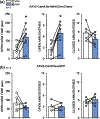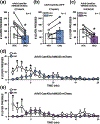Chemogenetic inhibition of a monosynaptic projection from the basolateral amygdala to the ventral hippocampus selectively reduces appetitive, but not consummatory, alcohol drinking-related behaviours
- PMID: 36840503
- PMCID: PMC10931538
- DOI: 10.1111/ejn.15944
Chemogenetic inhibition of a monosynaptic projection from the basolateral amygdala to the ventral hippocampus selectively reduces appetitive, but not consummatory, alcohol drinking-related behaviours
Abstract
Alcohol use disorder (AUD) and anxiety/stressor disorders frequently co-occur and this dual diagnosis represents a major health and economic problem worldwide. The basolateral amygdala (BLA) is a key brain region that is known to contribute to the aetiology of both disorders. Although many studies have implicated BLA hyperexcitability in the pathogenesis of AUD and comorbid conditions, relatively little is known about the specific efferent projections from this brain region that contribute to these disorders. Recent optogenetic studies have shown that the BLA sends a strong monosynaptic excitatory projection to the ventral hippocampus (vHC) and that this circuit modulates anxiety- and fear-related behaviours. However, it is not known if this pathway influences alcohol drinking-related behaviours. Here, we employed a rodent operant self-administration regimen that procedurally separates appetitive (e.g. seeking) and consummatory (e.g., drinking) behaviours, chemogenetics and brain region-specific microinjections, to determine if BLA-vHC circuitry influences alcohol and sucrose drinking-related measures. We first confirmed prior optogenetic findings that silencing this circuit reduced anxiety-like behaviours on the elevated plus maze. We then demonstrated that inhibiting the BLA-vHC pathway significantly reduced appetitive drinking-related behaviours for both alcohol and sucrose while having no effect on consummatory measures. Taken together, these findings provide the first indication that the BLA-vHC circuit may regulate appetitive reward seeking directed at alcohol and natural rewards and add to a growing body of evidence suggesting that dysregulation of this pathway may contribute to the pathophysiology of AUD and anxiety/stressor-related disorders.
Keywords: alcohol addiction; anxiety; motivation; seeking; ventral subiculum.
© 2023 The Authors. European Journal of Neuroscience published by Federation of European Neuroscience Societies and John Wiley & Sons Ltd.
Conflict of interest statement
CONFLICT OF INTEREST STATEMENT
The authors declare no competing financial interests.
Figures






Similar articles
-
Elevated GABAergic neurotransmission prevents chronic intermittent ethanol induced hyperexcitability of intrinsic and extrinsic inputs to the ventral subiculum of female rats.Neurobiol Stress. 2024 Aug 10;32:100665. doi: 10.1016/j.ynstr.2024.100665. eCollection 2024 Sep. Neurobiol Stress. 2024. Retraction in: Neurobiol Stress. 2024 Nov 12;33:100693. doi: 10.1016/j.ynstr.2024.100693. PMID: 39233783 Free PMC article. Retracted.
-
Negative modulation of AMPA receptors bound to transmembrane AMPA receptor regulatory protein γ-8 blunts the positive reinforcing properties of alcohol and sucrose in a brain region-dependent manner in male mice.Psychopharmacology (Berl). 2023 Jun;240(6):1261-1273. doi: 10.1007/s00213-023-06365-z. Epub 2023 Apr 13. Psychopharmacology (Berl). 2023. PMID: 37055596 Free PMC article.
-
Home treatment for mental health problems: a systematic review.Health Technol Assess. 2001;5(15):1-139. doi: 10.3310/hta5150. Health Technol Assess. 2001. PMID: 11532236
-
Psychological therapies for post-traumatic stress disorder and comorbid substance use disorder.Cochrane Database Syst Rev. 2016 Apr 4;4(4):CD010204. doi: 10.1002/14651858.CD010204.pub2. Cochrane Database Syst Rev. 2016. PMID: 27040448 Free PMC article.
-
Effectiveness of brief alcohol interventions in primary care populations.Cochrane Database Syst Rev. 2018 Feb 24;2(2):CD004148. doi: 10.1002/14651858.CD004148.pub4. Cochrane Database Syst Rev. 2018. PMID: 29476653 Free PMC article.
Cited by
-
Elevated GABAergic neurotransmission prevents chronic intermittent ethanol induced hyperexcitability of intrinsic and extrinsic inputs to the ventral subiculum of female rats.Neurobiol Stress. 2024 Aug 10;32:100665. doi: 10.1016/j.ynstr.2024.100665. eCollection 2024 Sep. Neurobiol Stress. 2024. Retraction in: Neurobiol Stress. 2024 Nov 12;33:100693. doi: 10.1016/j.ynstr.2024.100693. PMID: 39233783 Free PMC article. Retracted.
-
The neural, behavioral, and epidemiological underpinnings of comorbid alcohol use disorder and post-traumatic stress disorder.Int Rev Neurobiol. 2021;157:69-142. doi: 10.1016/bs.irn.2020.09.006. Epub 2020 Nov 4. Int Rev Neurobiol. 2021. PMID: 33648676 Free PMC article.
-
Sexually dimorphic effects of a modified adolescent social isolation paradigm on behavioral risk factors of alcohol use disorder in Long Evans Rats.Addict Neurosci. 2023 Dec 15;9:100134. doi: 10.1016/j.addicn.2023.100134. Epub 2023 Nov 4. Addict Neurosci. 2023. PMID: 38188062 Free PMC article.
-
Activating group II metabotropic glutamate receptors in the basolateral amygdala inhibits increases in reward seeking triggered by discriminative stimuli in rats.Int J Neuropsychopharmacol. 2025 Jun 6;28(6):pyaf030. doi: 10.1093/ijnp/pyaf030. Int J Neuropsychopharmacol. 2025. PMID: 40341317 Free PMC article.
-
Elevated GABAergic neurotransmission prevents chronic intermittent ethanol induced hyperexcitability of intrinsic and extrinsic inputs to the ventral subiculum of female rats.Neurobiol Stress. 2024 Dec 18;34:100696. doi: 10.1016/j.ynstr.2024.100696. eCollection 2025 Jan. Neurobiol Stress. 2024. PMID: 39801764 Free PMC article.
References
-
- Bach EC, Morgan JW, Ewin SE, Barth SH, Raab-Graham K, & Weiner JL (2021). Chronic ethanol exposure leads to a negative affective state in female rats that is accompanied by a paradoxical decrease in ventral hippocampus excitability. Frontiers in Neuroscience, 15, 669075. 10.3389/fnins.2021.669075 - DOI - PMC - PubMed
Publication types
MeSH terms
Substances
Grants and funding
LinkOut - more resources
Full Text Sources
Medical

